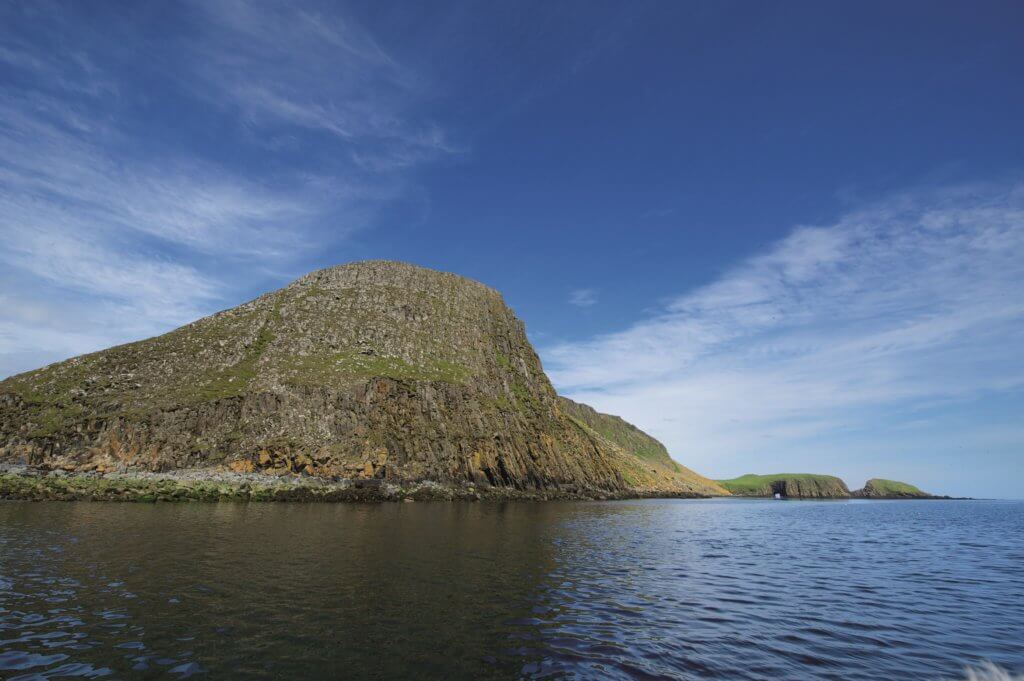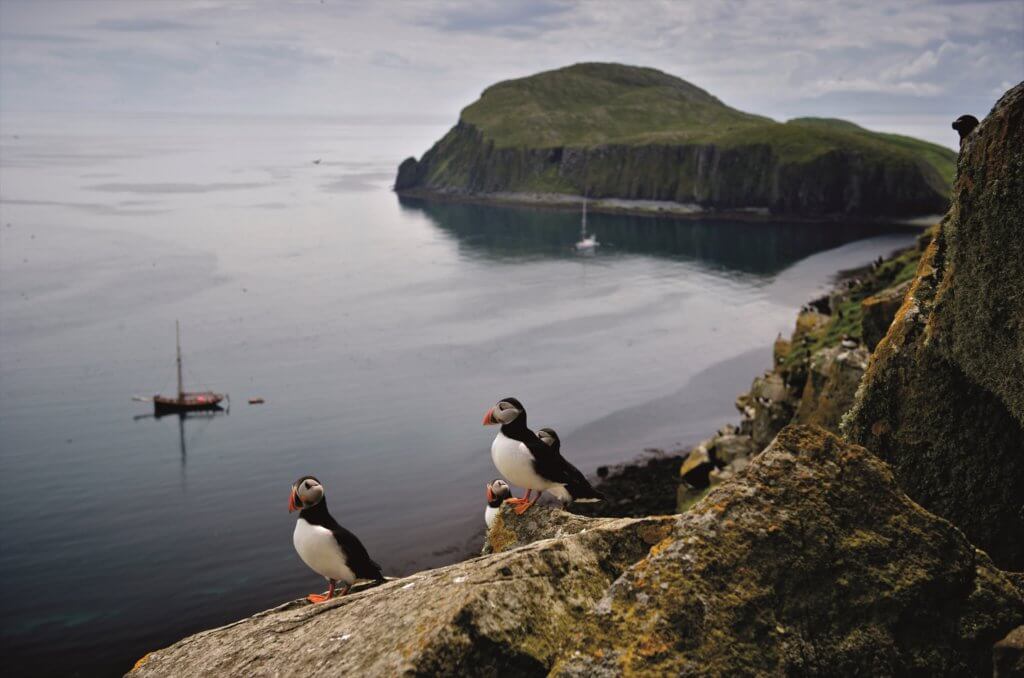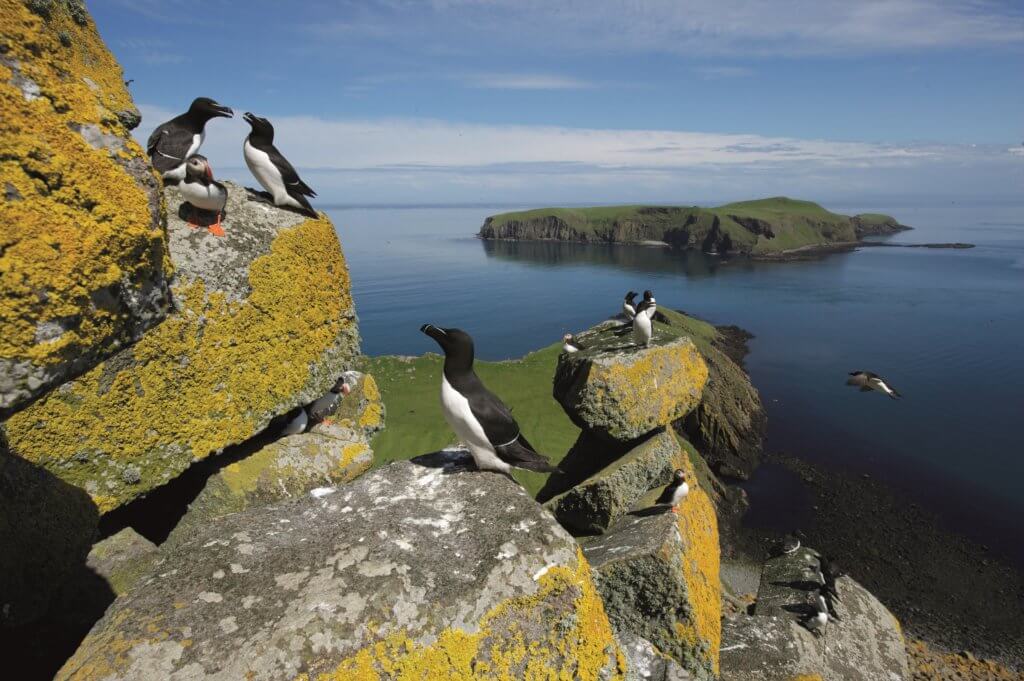
Brighter future for seabirds as Shiants declared rat free
Internationally important seabird colony
The Shiant Isles have been officially declared rat-free, thanks to a four-year partnership project to restore them as a secure haven for nesting seabirds. A month-long intensive monitoring check in February found no sign of rats. This means that none has been recorded there for two years, the internationally agreed criterion for rat-free status.
The EU LIFE+ funded Shiants seabird recovery project started in 2014 and is a partnership between the Nicolson family, custodians of the islands for three generations, Scottish Natural Heritage and RSPB Scotland. It has benefited from the help of many volunteers, and significant private donations.
Over the last four years the project has focused on making the islands a safe place for seabirds to raise their chicks by removing the invasive, non-native black rats that were found there. It has been a huge success and played an important role in developing future island restoration and biosecurity work in the UK.
Another key part of the project is a programme of research monitoring the response of the ecosystem to the removal of rats. It is anticipated that seabirds such as puffins, razorbills, and guillemots will see improved breeding successes which could eventually support population increases in these long lived seabirds breeding on the Shiants. It is hoped that Manx shearwaters and storm petrels will begin to nest on the islands as well.

The Shiants, a remote cluster of islands five miles east of the Isle of Lewis and Harris in the Outer Hebrides, is one of the most important seabird breeding colonies in Europe, hosting around 100,000 pairs of nesting seabirds each year. However, there was evidence that the rats fed on the seabirds’ eggs and chicks, having a detrimental impact on their breeding success. With many seabird populations facing a multitude of threats and severe declines in Scotland and around the globe, it was vital that action was taken to safeguard those nesting on the Shiants.
An operation to eradicate the rats was carried out over the winter of 2015/16, led by a New Zealand-based company Wildlife Management International Limited (WMIL), with the help of fifteen volunteers. This stage was incredibly challenging due to the rugged terrain and steep cliffs that make up the islands, and the Hebridean weather conditions including severe storms. Since then regular monitoring for signs of rats has been carried out with none recorded.
As well as the seabirds currently found on the islands, the Shiants offer suitable nesting habitat for European storm petrels and Manx shearwaters, two species of seabirds that are not generally found on islands with rats. Over the last two summers, the project has been working to encourage the storm petrels and Manx shearwaters to nest on the islands. The calling storm petrels, recorded on the islands last summer for the first time, gave a strong sign that the Shiants were free of rats ahead of this recent check.
In order to ensure that the islands remain free of rats, and other mammalian predators, visitors are being asked to follow simple biosecurity measures to help keep the islands rat free. This includes checking boats and all kit for signs of rats prior to departing for the Shiants, and looking out for signs of them when on the islands. Local boat operators along with SNH and RSPB Scotland staff have been trained in biosecurity measures by the project.
Dr Charlie Main, Senior Project Manager for the Shiant Isles Recovery Project said: ‘This is an absolutely fantastic moment for the Shiant Isles and everyone involved in the project is delighted that they are now officially rat free. With so many of Scotland’s seabird populations in decline it’s vital that we do all we can to help them. Making these islands a secure place for them to breed is really important.
Over the next few years we’re really looking forward to seeing the full impact of the islands’ restoration flourish with the seabirds enjoying improved breeding successes, and other species beginning to breed there as well. We’ll also continue to work with the local community to ensure this special place remains free of rats. This project has paved the way for more island restorations to take place around Scotland and give our threatened seabirds the best possible chance for the future.‘.
Andy Douse, Scottish Natural Heritage (SNH) ornithologist, said: ‘It’s wonderful news that this project has helped to protect the internationally important seabird colony on the Shiant Islands. The partnership between RSPB Scotland, WMIL, the Nicolson family and SNH has been a great success, particularly considering the complexity of the project, and we’d like to thank everyone involved. It was a great team effort, and we can now take the knowledge gained from this project into other work to protect Scotland’s special species and habitats.‘.
Tom Nicolson said: ‘Obviously this is a tremendous story of success on so many levels. When the idea was presented to us six years ago, the pure logistics of the project seemed hugely ambitious. Now, knowing that new species are beginning to thrive on the islands, so soon after the project has finished, there are no limits to what the Shiants could become over the next five, ten, twenty years.
It has been an immense pleasure working with such a talented and dedicated group of people from the RSPB and Scottish Natural Heritage – everyone involved should be thoroughly proud of themselves.’.

The Shiant Isles have a large population of seabirds, including tens of thousands Atlantic Puffins breeding in burrows on the slopes of Garbh Eilean, as well as significant numbers of Common Guillemots, Razorbills, Northern Fulmars, Black-legged Kittiwakes, Common Shags, gulls and Great Skuas. Although St Kilda has more puffins, the sheer density on the Shiants is greater
Dun Carloway was probably built some time in the 1st century BC, and radiocarbon dating evidence from remains found in the broch show that it was last occupied around 1300 AD. Photo: Jim Richardson
[registration_form]
Great new, I visited in 1972 and 73, one of the most wonderful places I have visited in the world. Congratulations to all.
This is great news and I hope that the success of the project can continue to be replicated on islands around the world where introduced rats and other mammalian predators are endangering breeding bird populations.
Meanwhile we need to become a good deal more careful about not transporting species from one part of the world to another where their establishment can lead to significant problems for the ecosystems into which they are introduced. It is, for example, depressing to see how we keep introducing new tree pathogens with imported saplings.
This is excellent news, and I am not surprised it has been led by a New Zealand company, which has a good record of repairing island eco-systems from invasive species. Animal Aid and Peta would be appalled.
This is great news and a major success story. Many congratulations must go to the three participating parties, namely the RSPB and their volunteers, The Nicholson family and Scottish Natural Heritige. It make cheering news on a cold snowy afternoon and amid a steady stream of depressing news from our upland moorlands added to by Natural England and Defra.
I do feel that currently the “climate” in Scotland is, thanks to a considerable extent to their present Government, much better than in England for improving and protecting wildlife and biodiversity
What a shame the rats were eradicated rather than relocated. It wasn’t their fault that they happened to live on the islands.
I agree that it was not the rats’ fault that they were transported to the islands in the first place but can you suggest a practical way in which they could all (it has to be all of them, I’m afraid, there is no point in just removing some or even most) have been removed alive from the Shiants or where they could have been relocated to?
You could leave one. Male, to be certain
Fair point 🙂
As someone who volunteered on the project.
Black rats (Rattus rattus) have a wide distribution across the world. Where they have colonised new areas it has been mainly via human activity. They are not native to the UK and are thought to arrived on the islands from a ship wreck. It would not have been feasible to trap and translocate them.
The rats were having a major impact on the breeding seabirds and are likely to have impacted all aspects of the ecology of the island including the vegetation.
From a purely practical perspective, having ringed auks there, the prospect of rats in your foodstores isn’t attractive. On many other islands I’ve suffered from rats in bedding, soap stealing – a speciality on Rhum, and other issues. The loss of chicks to rats is not good. So, well done, and if that means that everything doesn’t have to be kept in metal boxes when out ringing, that can only be a good thing
Awesome no rats, no disease either, equates obviously to more bird life. I have just finished reading Sea Room, author Adam Nicholson, I am sure he will be especially pleased no more rats in his beloved Islands, and Proud his son, has aided in the eradication of rats.